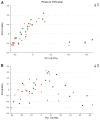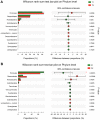Effects of probiotics on chemotherapy in patients with lung cancer
- PMID: 30854059
- PMCID: PMC6365978
- DOI: 10.3892/ol.2019.9906
Effects of probiotics on chemotherapy in patients with lung cancer
Abstract
Chemotherapy damages the intestinal mucosa, causing adverse gastrointestinal reactions. Clostridium butyricum (C. butyricum) reduces the incidence of diarrhea in digestive diseases, including inflammatory bowel disease. Therefore, the aim of the present study was to investigate the role of C. butyricum in patients undergoing chemotherapy. A total of 41 participants with lung cancer were enrolled, and divided into the C. butyricum (CB) or placebo group using 1:1 randomization to obtain 20 CB and 21 placebo participants. On the first and last day of the 3-week intervention, blood and stool samples were collected and analyzed. To analyze stool flora, 16S ribosomal RNA sequencing was performed. The incidence of chemotherapy-induced diarrhea was lower in the CB group compared with the placebo group. The lymphocyte count and platelet/lymphocyte ratio (PLR) was markedly altered between the two groups. Neutrophil/lymphocyte ratio (NLR) and PLR decreased within the CB group. At week 3, the lymphocyte/monocyte ratio (LMR) was higher in the CB group compared with the placebo group. Alterations in lymphocyte subsets and immunoglobulin levels were not significantly different. Albumin (ALB) level and weight did not differ significantly between the two groups. At 3 weeks the total flora diversity did not decrease in either group. Phyla in the CB group varied slightly, while the proportion of Firmicutes in the placebo group decreased significantly. No statistically significant difference was observed between the two groups, though the genera producing short-chain fatty acids tended to increase, and the pathogenic genera tended to decrease in the CB group, which was almost the opposite of the observation in the placebo group. Operational taxonomy unit analysis revealed a notable increase in beneficial flora, including the Clostridium and Lactobacillus genera of the CB group, compared with the placebo group. The present study highlighted that C. butyricum reduced chemotherapy-induced diarrhea in patients with lung cancer, reduced the systemic inflammatory response system and encouraged homeostatic maintenance.
Keywords: chemotherapy; intestinal microflora; probiotic; systemic inflammatory response.
Figures







Similar articles
-
Effects of Clostridium butyricum and Enterococcus faecalis on growth performance, immune function, intestinal morphology, volatile fatty acids, and intestinal flora in a piglet model.Food Funct. 2019 Dec 11;10(12):7844-7854. doi: 10.1039/c9fo01650c. Food Funct. 2019. PMID: 31793606
-
Effects of dietary supplementation of probiotic, Clostridium butyricum, on growth performance, immune response, intestinal barrier function, and digestive enzyme activity in broiler chickens challenged with Escherichia coli K88.J Anim Sci Biotechnol. 2016 Jan 26;7:3. doi: 10.1186/s40104-016-0061-4. eCollection 2016. J Anim Sci Biotechnol. 2016. PMID: 26819705 Free PMC article.
-
Effect of Clostridium butyricum supplementation on the development of intestinal flora and the immune system of neonatal mice.Exp Ther Med. 2018 Jan;15(1):1081-1086. doi: 10.3892/etm.2017.5461. Epub 2017 Nov 7. Exp Ther Med. 2018. PMID: 29434698 Free PMC article.
-
Probiotic Clostridium butyricum Improves the Growth Performance, Immune Function, and Gut Microbiota of Weaning Rex Rabbits.Probiotics Antimicrob Proteins. 2019 Dec;11(4):1278-1292. doi: 10.1007/s12602-018-9476-x. Probiotics Antimicrob Proteins. 2019. PMID: 30324399
-
A breakthrough in probiotics: Clostridium butyricum regulates gut homeostasis and anti-inflammatory response in inflammatory bowel disease.J Gastroenterol. 2015 Sep;50(9):928-39. doi: 10.1007/s00535-015-1084-x. Epub 2015 May 5. J Gastroenterol. 2015. PMID: 25940150 Review.
Cited by
-
Oral compound probiotic supplements can improve the quality of life for patients with lung cancer during chemotherapy: A randomized placebo-controlled study.Thorac Cancer. 2024 Jan;15(2):182-191. doi: 10.1111/1759-7714.15177. Epub 2023 Nov 29. Thorac Cancer. 2024. PMID: 38018652 Free PMC article. Clinical Trial.
-
Next generation probiotics for human health: An emerging perspective.Heliyon. 2024 Aug 12;10(16):e35980. doi: 10.1016/j.heliyon.2024.e35980. eCollection 2024 Aug 30. Heliyon. 2024. PMID: 39229543 Free PMC article. Review.
-
Respiratory diseases and gut microbiota: relevance, pathogenesis, and treatment.Front Microbiol. 2024 Jul 16;15:1358597. doi: 10.3389/fmicb.2024.1358597. eCollection 2024. Front Microbiol. 2024. PMID: 39081882 Free PMC article. Review.
-
Evaluating the Role of Probiotics in the Prevention and Management of Age-Related Diseases.Int J Mol Sci. 2022 Mar 26;23(7):3628. doi: 10.3390/ijms23073628. Int J Mol Sci. 2022. PMID: 35408987 Free PMC article. Review.
-
Microbiome as a Target for Cancer Therapy.Integr Cancer Ther. 2020 Jan-Dec;19:1534735420920721. doi: 10.1177/1534735420920721. Integr Cancer Ther. 2020. PMID: 32564632 Free PMC article. Review.
References
-
- Howington JA, Blum MG, Chang AC, Balekian AA, Murthy SC. Treatment of stage I and II non-small cell lung cancer: Diagnosis and management of lung cancer, 3rd ed: American College of Chest Physicians evidence-based clinical practice guidelines. Chest. 2013;143(5 Suppl):e278S–e313S. doi: 10.1378/chest.12-2359. - DOI - PubMed
LinkOut - more resources
Full Text Sources
Other Literature Sources
Miscellaneous
